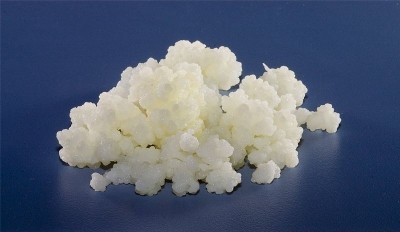Kefir grain sugars eyed as healthy gelling agent
after freeze-drying and may offer a novel gelling agent for
industry, suggests new research from Argentina.
The cryogenic gels were influenced by the concentration of kefiran, a water-soluble glucogalactan, and the physicochemical properties of the 'cryogels' could melt at mouth temperature, indicating their potential for food applications. "This is the first report on the ability of an exopolysaccharide (EPS) from lactic acid bacteria to form gels at low temperature with interesting properties for the application in food formulations," wrote lead author Judith Piermaria in the journal Food Hydrocolloids. Piermaria and co-workers, from the Facultad de Ciencias Exactas, UNLP in La Plata, report that the polysaccharide behaves like an 'entangled solution', and thereby can contribute to the viscosity (thickness) of the food system. Subjecting the solution to a freeze-thaw cycle - freezing, storage in the frozen state and subsequent defrosting - results in the formation of a gel, said the researchers. Kefir, which orginates from the Caucasus region in Russia, is popular in Eastern and Central Europe but is also gaining awareness among West European consumers for its probiotic and nutraceutical properties. The fermented milk contains a mixture of several live microorganisms and has many of the nutrients required by the body: proteins, minerals and vitamins. Its acidity and enzymes stimulate protein digestion and appetite and decreases the cholesterol content in blood, according to research. It is also thought to stimulate microphage production, improving immunity. The cryogels produced in the new study are described by the researchers as "translucent and sufficiently cohesive to support their own weight and have a high water holding capacity." They also note that, while the viscosity of kefiran is lower than some foods additives such as locus bean gum or guar gum, it is higher than others, such as dextran. Interestingly, they note that a melting process for the kefiran cryogels occurs around 37 degrees Celsius. "The behaviour of kefiran cryogels at about 37 degrees Celsius determines its ability to melt at mouth temperature and is interesting for the application in food formulations," wrote Piermaria. More research is needed to further explore the possibilities and potential applications for the polysaccharide, but this preliminary study appears promising. "Kefiran is a water-soluble glucogalactan, which has been reported to have antibacterial and anti-tumour activity, modulates gut immune system and protects epithelial cells against Bacillus cereus exocelullar factors," explained the researchers. "Taking into account that the extraction method of kefiran from grains was simple with a good yield of extraction and that de-proteinised whey could be utilised as substrate for kefir grain biomass production, further application could be considered for this biopolymer." Source: Food Hydrocolloids Published on-line ahead of print 27 October 2007, doi: 10.1016/j.foodhyd.2007.10.005 "Gelling properties of Kefiran, a food grade polysaccharide obtained from kefir grain" Authors: J.A. Piermaria, M.L. de la Canal and A.G. Abraham







